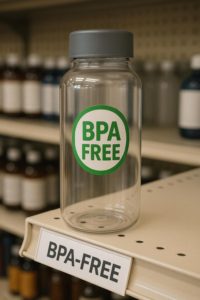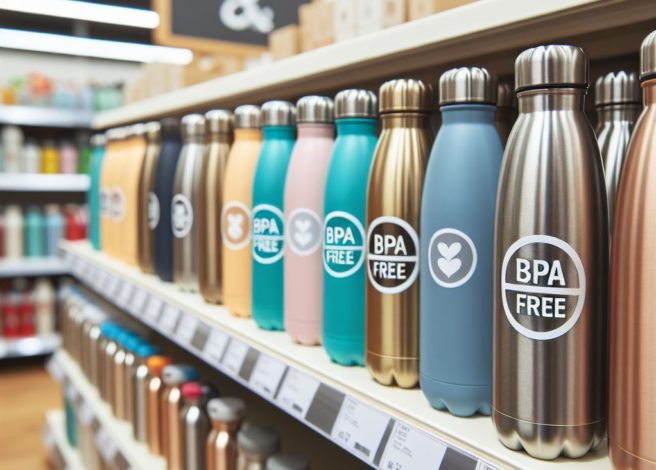At a Glance
- BPA-free packaging is a top priority, as consumers and regulators demand materials without bisphenol A due to health concerns.
- Alternative materials like PET, HDPE, and polypropylene avoid BPA but should still be vetted for migration and food contact safety.
- Supplier certifications and testing ensure compliance and prevent unexpected chemical exposures.
- Transparent labeling and communication build trust — letting customers know you choose BPA-free options boosts confidence in your brand.
You’ve seen it on water bottles, food containers, and various packaging materials: “BPA-Free.” This label has become so common that consumers actively look for it, but what exactly is BPA, and should food business owners be concerned? In a world where even kale chips have warning labels, it’s tough to know which chemicals to worry about first.
As a food business professional, you’re on a mission to provide safe, quality products to your customers. On this journey, you’ve probably met people who examine product labels like crime scene detectives. They often point out ingredients they struggle to pronounce. These encounters might leave you wondering: What’s the real story behind BPA? Is it something you should worry about in your business, or just another entry in the ever-expanding encyclopedia of things to fear?
Getting Answers
This week, we had the opportunity to interview Conor Carlin, the Founder and President of Clefs Advisory LLC. Conor operates at the intersection of packaging and sustainability and notably held the position of President of the Society of Plastics Engineers in 2024. Before establishing his own advisory firm, he worked as the General Manager for ILLIG’s North American operations. Conor brings extensive knowledge in areas including materials science, packaging technologies, policy formation, commercial strategy, and market intelligence to the industry.
This article will guide you through the often-confusing topic of BPA and food packaging world. What BPA actually is, where it’s found (and where it isn’t), why concerns emerged, and what science really tells us will be explored. Most importantly, we’ll equip you with practical knowledge. This will help you make better decisions and confidently tackle customer questions.
By the end of this article, you’ll have clarity on this often-misunderstood topic, allowing you to focus on what matters most: running your successful food business without unnecessary worry about packaging safety.
Understanding BPA: Origins, Applications, and Concerns
 Bisphenol A (BPA) is a synthetic chemical compound used in the manufacture of certain plastics and resins, including polycarbonate plastics and epoxy resins. Epoxy resins, made from BPA and epichlorohydrin, are thermoset polymers that cannot be melted and reshaped once cured. In contrast, thermoformed plastics, including PET, PP, and PS, are thermoplastics that can be reheated and reshaped, and are commonly used in food packaging. Most thermoformed food packaging materials are BPA-free.
Bisphenol A (BPA) is a synthetic chemical compound used in the manufacture of certain plastics and resins, including polycarbonate plastics and epoxy resins. Epoxy resins, made from BPA and epichlorohydrin, are thermoset polymers that cannot be melted and reshaped once cured. In contrast, thermoformed plastics, including PET, PP, and PS, are thermoplastics that can be reheated and reshaped, and are commonly used in food packaging. Most thermoformed food packaging materials are BPA-free.
Polymers are sometimes compared to spaghetti. When you heat spaghetti, it becomes soft and flexible, much like thermoplastic polymers, which soften and can flow when heated. When cooled, both stiffen again (though only polymers can solidify reversibly in a technical sense). They are flexible and can be reshaped with high temperatures. Thermosets, by contrast, including epoxies, are more like uncooked spaghetti — rigid, fixed, and unable to be reshaped once set. This distinction is crucial for understanding where BPA is actually found in our food system.
Where Is BPA Today?
Despite common misconceptions, BPA is not found in most plastic food containers you are likely to use in your business. Its traditional food-related applications include:
- Metal can linings: In certain amounts, a thin epoxy film with BPA has been used to protect canned foods. It helps stop metal contamination and prevents rust and corrosion that harm food safety. A 2018 survey by the Can Manufacturers Institute, however, reported that at least 90% of food cans had transitioned away from BPA-based linings.
- Thermal paper receipts can contain more BPA than the amount that leaches from polycarbonate containers (see below). This is quite surprising. Many businesses have now switched to BPA-free receipt paper.
- Polycarbonate: BPA is used in the production of polycarbonate, a durable, clear material used in 5-gallon water jugs, jewel boxes, optical media, and, historically, in baby bottles. Two examples of major manufacturers offering BPA alternatives include Covestro’s Makrolon® RE and Eastman’s Tritan™.
Public concern about BPA began primarily in the early 2000s, culminating in significant action around 2008. Research shows that BPA exposure may disrupt hormones in the body. This is especially concerning for developing children. This led to focused regulation of products that children might use, such as baby bottles and sippy cups.
By 2018, U.S. and E.U. laws limited BPA in many containers. These laws mainly targeted items for children and those exposed to heat, which can cause BPA leaching.
The Science Behind the Headlines: Understanding Risk in Context
The Dose Makes the Poison
When evaluating any potential chemical concern, context matters immensely. Regulatory agencies set safety limits based on thorough testing. Scientists often measure these limits in parts per billion or even parts per trillion. Simply put, parts per billion is like finding one person in the world. It’s also similar to seeing one ant on a football field from a Goodyear blimp. Parts per trillion? That’s like trying to find one specific second in 32,000 years (the approximate time it takes to read War and Peace, from cover to cover).
Most concerns about BPA come from lab studies that use much higher exposure levels than what people actually face. This is a crucial distinction when evaluating risk. Divergence in regulations from the U.S. FDA to the E.U.’s EFSA, however, should be monitored.
Scientific Rigor and Reproducibility
A key part of scientific research is reproducibility. This means other scientists should be able to replicate the findings. Many sensational claims about chemicals like BPA fail this crucial test. Researchers should cautiously regard single studies they can’t reproduce and avoid treating them as clear proof.
What Food Business Owners Need to Know: Practical Takeaways

Image created using AI.
Clearing Up Common Misconceptions
Myth #1: PET plastic food containers contain BPA.
Reality: PET (polyethylene terephthalate, a tongue-twister!) containers, commonly used for beverages and food packaging, do not contain BPA in their formulation. Recyclers probably introduce the contamination that causes the rare reports of BPA in PET, not the original manufacturing process.
Myth #2: All plastics contain harmful BPA.
Reality: Most food-grade plastics never had BPA. This includes common packaging materials like PET, HDPE, LDPE, and PP.
Myth #3: BPA in food packaging poses a significant health risk.
Reality: Manufacturers still use BPA, mainly in can linings. The amounts that might enter food are very small and well below safety limits.
Advertising Misconceptions About BPA
It’s important to note that many products advertised as “BPA-Free” never had BPA in them to begin with. This is an example of advertising using a fear tactic to sell products that were never a danger in the first place. It’s just as effective to advertise a sweatshirt, a wallet, or even a goldendoodle as BPA-Free. Note: It’s important to mention that a product that is advertised as BPA-Free shouldn’t be misconstrued as “healthy” or “improved.”
Future-Proofing Your Business
Regulators and industry leaders have mostly addressed BPA concerns through regulations and changes. Understanding packaging materials helps you make smart choices. It also lets you answer customer questions effectively. Here are some actionable steps:
- Know your packaging: Understand the materials used in your packaging and their properties.
- Communicate with confidence: When customers have concerns, share clear information. This helps them see risks more clearly.
- Stay informed: Food packaging technology is always changing. Innovations tackle safety and sustainability issues.
Looking at BPA Practically
BPA has been widely studied and identified as a potential endocrine disruptor. While the U.S. FDA continues to assert that current exposure levels from plastics and food packaging are safe, the European Food Safety Authority (EFSA) recently set a drastically lower safety threshold, suggesting that current exposures, especially dietary, may exceed safe levels. Although plastics can be a source, thermal paper receipts and certain occupational settings often contribute to higher BPA exposure.
 The food industry has responded responsibly to BPA concerns, with manufacturers reformulating products where warranted and regulatory agencies establishing appropriate safeguards. The plastic food containers most commonly used in today’s food businesses have never contained BPA.
The food industry has responded responsibly to BPA concerns, with manufacturers reformulating products where warranted and regulatory agencies establishing appropriate safeguards. The plastic food containers most commonly used in today’s food businesses have never contained BPA.
Knowing the science of packaging materials helps you focus on what counts: serving safe, tasty food to your customers. While it’s always important to stay informed about the materials that contact the food you serve, scientists and industry leaders have largely addressed concerns about BPA in food packaging through science-based approaches and responsible action.
With accurate information about materials like BPA, you can confidently assure your customers that their food safety is in good hands — yours.
Do you want to learn more about plastic food packaging? Visit our Learning Center today!
Would you like to know more about Conor Carlin and his work at Clefs Advisory LLC? Connect with him on LinkedIn today.
**Disclaimer: This article aims to provide food business owners with accurate, contextual information about BPA. While comprehensive, it does not constitute regulatory or legal advice. Always consult appropriate regulatory agencies for specific guidance related to your business practices.

